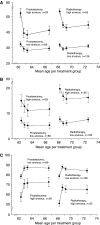Anxiety and depression after prostate cancer diagnosis and treatment: 5-year follow-up
- PMID: 16622434
- PMCID: PMC2361242
- DOI: 10.1038/sj.bjc.6603057
Anxiety and depression after prostate cancer diagnosis and treatment: 5-year follow-up
Abstract
To document anxiety and depression from pretreatment till 5-year follow-up in 299 men with localized prostate cancer. To assess, if baseline scores were predictive for anxiety and depression at 1-year follow-up. Respondents completed four assessments (pretreatment, at 6 and 12 months, and at 5-year follow-up) on anxiety, depression and mental health. Respondents were subdivided according to therapy (prostatectomy or radiotherapy) and high vs low-anxiety. Pretreatment 28% of all patients were classified as 'high-anxiety'; their average anxiety scores decreased significantly post-treatment, that is towards less anxiety. At all assessments, high-anxiety men treated by prostatectomy reported less depression than high-anxiety men treated by radiotherapy. Of men treated by radiotherapy, 27% reported clinical significant levels of depression while 20% is expected in a general population. The improvement in mental health at 6-months follow-up was statistically significant and clinically meaningful in all respondent groups. Sensitivity of anxiety at baseline as a screening tool was 71% for anxiety and 60% for symptoms of depression. We recommend clinicians to attempt early detection of patients at risk of high levels of anxiety and depression after prostate cancer diagnosis since prevalence is high. STAI-State can be a useful screening tool but needs further development.
Figures
References
-
- Arapaslan B, Soykan A, Soykan C, Kumbasar H (2004) Cross-sectional assessment of psychiatric disorders in renal transplantation patients in Turkey: a preliminary study. Transplant Proc 36: 1419–1421 - PubMed
-
- Balderson N, Towell T (2003) The prevalence and predictors of psychological distress in men with prostate cancer who are seeking support. Br J Health Psychol 8: 125–134 - PubMed
-
- Bouma J, Ranchor AV, Sanderman R, van Sonderen E (1995) Het meten van symptomen van depressie met de CES-D [Measuring symptoms of depression using the CES-D]. Rijksuniversiteit Groningen, Noordelijk Centrum voor Gezondheidsvraagstukken: Groningen
-
- Galbraith ME, Ramirez JM, Pedro LW (2001) Quality of life, health outcomes, and identity for patients with prostate cancer in five different treatment groups. Oncol Nurs Forum 28: 551–560 - PubMed


